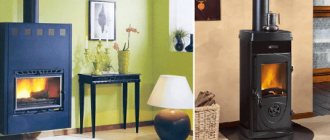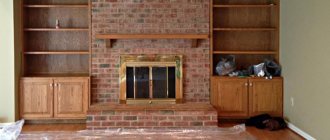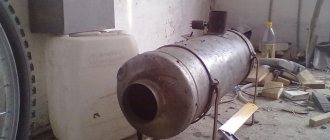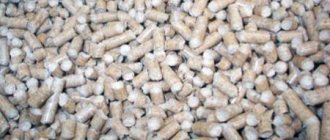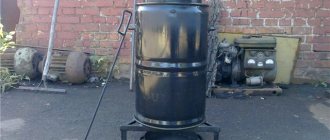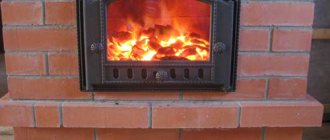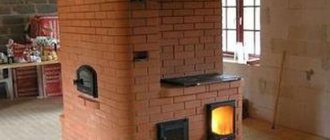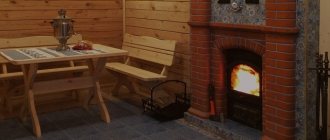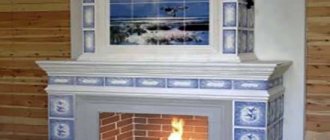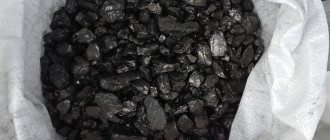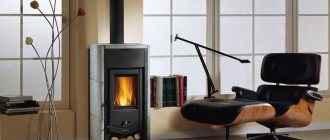Features of Vesuvius furnaces
Vesuvius models are distinguished by the complete absence of sharp corners. The design of the stove has a rounded shape, which allows heat radiation to be evenly distributed throughout the room, warming up the air to the specified temperatures. The outer casing of the unit is an all-welded steel plate construction. The thickness of the metal is 8 mm. The plates are bolted. The fastening provides increased product strength.
Thanks to the outer mesh, the stones in the oven are heated evenly. They extinguish the infrared radiation of the hot metal. The downside of the outdoor mesh is dry steam. It is impossible to get a light wet cloud without additional devices. For lovers of the Russian steam room, it is better to give preference to models with a closed heater. The full use of an open-type heater in a Russian bath involves the additional installation of a steam generator.
The body of the Vesuvius furnace is coated with a protective organosilicon compound. The coating protects it from high temperatures and humidity. Some models are decorated with forged details. Typical for models with fireplace function. If necessary, you can hide the equipment behind a brick screen; models without complex decor are purchased.
All Vesuvius models have a standard chimney diameter of 115 mm and a combustion tunnel depth of 290 mm. This is useful when replacing assemblies.
The warranty period for cast iron models is 35 years.
Vesuvius stove model The Legend is constructed of 3 cast iron parts. The thickness of the material is 12 mm. The joints of the fragments are sealed with a ceramic cord. The operating temperature that the cord can withstand is 1200 degrees. This is enough for a sauna stove. All parts are bolted. The branch pipe is separated from the chimney firebox by a baffle.
The stone net is installed outside. When heated, stones give a uniform heat and shields the radiation of the firebox. The large mass of stones provides light steam. The humidity of the vapor cloud depends on the heating temperature and the amount of water in the tank. You can add water to the stones from above. In this case, the steam will turn out to be heavy, watery. The steam room is heated for an hour.
In the Legend series, the manufacturer produces furnace models with forged elements.
The manufacturer gives a 30-year guarantee for the Vesuvius Legend model. The model from the Forging series has a remote firebox. The element makes it possible to heat the steam room from the adjacent room.
Furnace Vesuvius Scythian
A series of models "Vesuvius" Skif - a budgetary line of the manufacturer. They are constructed from engineered steel. Sheet thickness 12 mm. This type of steel has a long service life. The walls do not bend outward, do not deform. The stove is made according to Finnish technology. The joints are laid with a heat-resistant cord. The part can withstand temperatures up to 1200 degrees. The parts are bolted together. The furnace is portable. The steam room is heated from the adjacent room.
The stone net is installed outside. The steam is dispersed. Due to the design of the oven, it is suitable for a Finnish steam room. For a classic Russian steam room, the unit lacks moisture. This is compensated by the additional installation of a steam generator or piping system. The steam room for the standard model ranges from 8 to 18 square meters.
The advantage of the Skif oven is its price. It is cheaper than a cast iron product. The warranty period is 2.5 - 3 years.
Vesuvius 16
Vesuvius 16 is a closed heater. Consists of three elements: body, firebox, pipe. The parts are fastened with a bolted connection. It increases the strength of the structure. A ceramic cord is laid at the joints. The working temperature of the wire is 1200 degrees.
The model is equipped with a sealed cast iron door.The design provides for the presence of heat-resistant glass. The body is made of steel. The ventilated oven casing is made of textured metal sheets. They are coated with a heat-resistant bronze color. The oven is heated from a room adjacent to the steam room. For this, it is equipped with a combustion tunnel.
A steam room up to 18 cubic meters in size Vesuvius 16 will warm up in 50 minutes. The heat-resistant glass built into the door allows you to watch the wood burning in the stove.
Why "Vesuvius" is so fond of the bathhouse attendants?
The stove is being developed by domestic engineers and enjoys considerable success both in Finnish saunas and in classic Russian baths. The Vesuvius stove is an all-welded convection-type design, durable and practical. The firebox is made of high-strength steel and is 8 mm thick. In the lower part there is a high-quality cast iron grate. And it is placed in the Vesuvius bathhouse so as to heat it from a room adjacent to the steam room.
These are the main advantages of these loudly named ovens:
- Balanced efficiency of heating stones and air;
- The heater has a large enough capacity;
- Minimum load of stones on the collector;
- Stylish ergonomic design;
- Complete absence of sharp corners;
- Self-cooling door with a huge heat-resistant glass, and even with a self-cleaning system.
These bath stoves are also praised for the fact that it is very convenient to use the convection control dampers in them, the casing of the stove does not "fade" at all, as the bath attendants like to say, and the heat in the steam room literally reaches 80 ° C in an hour and a half and lasts long enough.
Benefits of wood heating
When choosing a boiler to heat their home, people compare the strengths and weaknesses of certain options. Having looked at several types of slow burning wood stoves, we will get acquainted with the benefits of wood heating in general. Compared to other types of heating, it has quite a few strengths:
- Environmental friendliness. The wood-burning stove does not harm the environment, and in this regard, it simply has no equal. Burning wood emits no more carbon dioxide than when rotting in its natural environment. And compared to the harm that other types of fuel cause to the environment, this is just a trifle.
- Profitability. Unfortunately, many people think first of all about the financial benefit, and then about the environment. But in this regard, wood-burning stoves have succeeded. Firewood costs less than other fuels.
- This unit can be used not only for heating housing, but also for cooking. This is especially true for those whose home is far from the gas pipeline.
- For all the efficiency of wood heating, it is not at all difficult. If everything is done correctly, the stove, even without radiators, will warm up the house well.
- The stove draft creates heat exchange between the street and the house, thereby achieving an optimal temperature level and normalizing humidity
- The wood-fired boiler gives off a pleasant aroma, creates a cozy atmosphere and reminds us of our roots.
Installing the Vesuvius furnace
The installation of the stove is the most important event. The equipment interacts with combustible materials in the room. During installation, fire safety standards must be strictly observed. But before describing the installation process, a few words should be said about choosing a model.
The market offers the installation of metal heaters in the bathhouse and stone ones. Metal models win with their practicality and safety. The choice of model depends on factors:
- the volume of the paired room;
- type of insulation;
- the area of the entire bath;
- desired values of temperature and humidity in the steam room;
- heating time.
Attention! Having decided to install the device yourself, you need to carefully read the manufacturer's instructions. It indicates the installation features of a particular model.
The first step is to prepare the floor. The installation area of the furnace is covered with a metal sheet, or brickwork is mounted.Indents are made by 15-20 centimeters on all sides. The top is covered with a steel sheet or a cement screed is poured.
The oven is installed on the surface, observing the indents. They are spelled out in the installation instructions for a particular model.
Important! The distance from the stove to the ceiling is 120 centimeters, from the heater to the partitions at least 32 cm.
It is possible to reduce the distance by a few centimeters if there is additional protection in the form of a metal sheet.
When installing the stove, the direction of the heating chamber should be taken into account. Models may involve stowing fuel from adjacent rooms. This condition complicates the installation, but provides more advantages in the operation of the furnace.
The next step is the installation of a hinged tank. It is installed in an adjacent room, or, in accordance with the instructions, to a specific furnace model.
The heat exchange system consists of the following parts:
- heat exchanger;
- fittings;
- remote tank;
- connection elements.
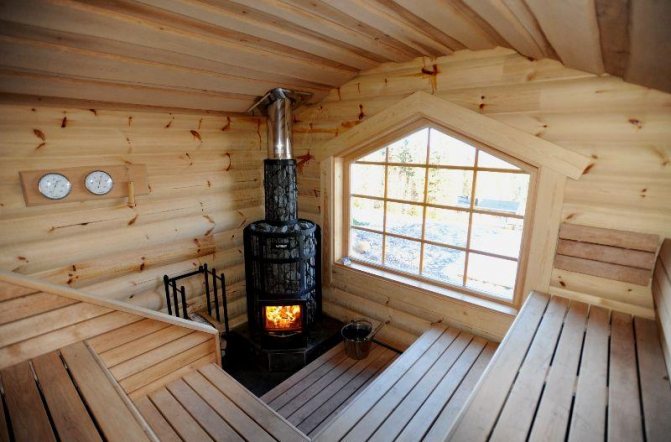
In the process of installing the heat exchange system, you should not use flexible plastic or rubber liners. In order to avoid freezing of water in the system in winter, a drain valve is built into the lower part of the fitting.
The last step is to install the pipe. It must be at least 5 meters long. It is worth paying attention to the chimney pipe. It is made from refractory materials. The height of the pipe should be higher than the level of the roof of the nearest houses.
The oven is only started after a thorough check of all connections and fasteners. When heating for the first time, an unpleasant smell of burning and chemical products may be felt. This burns the oils that got into the unit during the manufacturing process. It is worth heating for an hour. During this time, the tank, the heat exchange system and other parts of the furnace are checked.
Heat exchanger for Vesuvius furnace
The heat exchanger for the Vesuvius oven looks like a geometric stainless steel tank. Material thickness 1 mm. It is intended for heating water in rooms adjacent to the steam room. The heat exchanger is attached to heating and water supply systems using a union. To prevent depressurization of the welds, water is poured into the heat exchanger before starting the system.
Plastic pipes must not be brought close to the heat exchanger. The material is not able to withstand high temperatures. A metal corrugated pipe is used for the tank.
Water circuit
A slow-burning stove with a water circuit, unlike a simple stove, can heat several rooms at once. In addition to their high heating efficiency, such stoves, as a rule, have an interesting modern design that can be matched to the interior of the house. This is another feature that distinguishes them from products that are installed in garages, basements, boiler rooms or, in extreme cases, in small, rarely visited summer cottages.
We suggest that you familiarize yourself with the Kuznetsov bell-type stove for a bath with your own hands: ordering, drawings and diagrams
With the right choice, a slow burning wood burning stove with a water circuit can become a true decoration of the interior and an alternative to a fireplace. Particularly popular are models whose firebox has a transparent front wall. The visual effect plays a major role here. After all, fire creates a cozy, peaceful atmosphere in the house. It turns out not just a stove, but a kind of slow-burning fireplace stove.
Thanks to the use of a system of pipes and radiators, the stove perfectly heats the whole house. At the same time, it allows you to significantly save on firewood, not to mention saving gas and electricity. If the stove is not regularly heated in severe frosts, then it is very likely that the water in the pipes will freeze.
So which model should you choose?
When developing the Rusich model range, engineers relied on the experience of foreign and domestic manufacturers, choosing what works and what is effective.And here's the bottom line: a voluminous ventilated heater that heats stones from four sides in record time. And the process is helped by an external casing-convector, which forms a rather powerful convection flow in the steam room. In fact, "Rusich" is the fastest stove for heating a bath.
In the Skif model range, it was decided to combine the advantages of metal and brick ovens: to make an extra-large convection-ventilated casing for a huge amount of stones that will heat up to 350˚C. And those - for a long time to accumulate valuable heat. And the stones in these models are placed in a casing on all sides of the firebox, protecting it at the same time from hard infrared radiation, which is difficult to get rid of in conventional metal furnaces. A simple and at the same time unique solution.
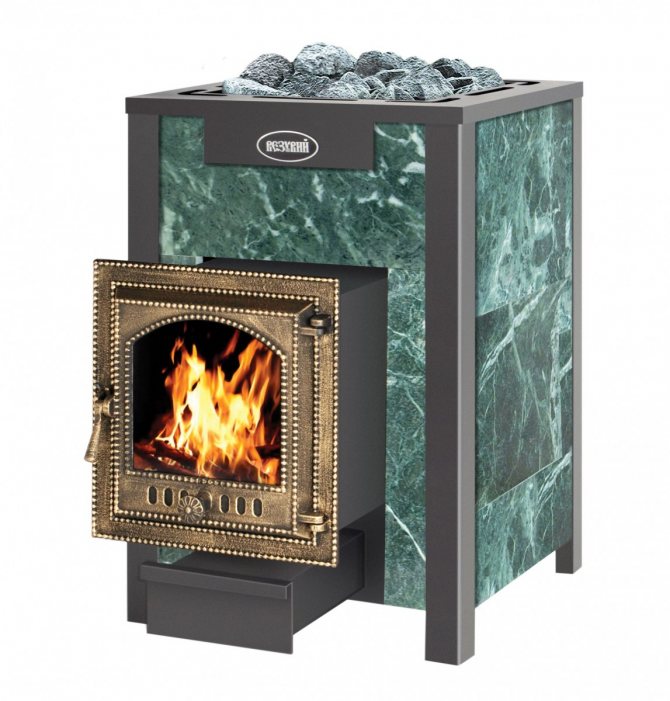

Lava models differ from others in their special structural steel and ventilated casing with spectacular forging elements. Such ovens warm up the steam room almost as quickly as Rusich.
Recently, the “Vertical” model line has also become popular - it is in it that advanced technologies are 100% incorporated: a combustion chamber with afterburning of exhaust gases, double flame circulation and, as a result, increased efficiency of the furnace. In fact, this is generally the only stove in Russia that has a double circulation of the flame and afterburning of gases - it is not for nothing that it is chosen first of all by those who really understand sauna stoves and their functioning, and not only determine something by one external design.
But for true connoisseurs of the spirit of the Russian bath, the Vesuvius "Premium" lineup was specially created. Convection-ventilated lining made of pure mountain coil is the secret of such ovens. They warm up quickly, and keep warm and stable temperature for a really long time. Plus, the stylish appearance of the stone and the healing properties of the coil itself.
But for a real Russian bath with its special humid microclimate, the model "Russian steam" is most suitable - its name speaks for itself. In the upper part of the stove there is a stove designed for 60 kg of stones - and they will heat up to 400˚С. As a result, the steam turns out to be fine, dispersive and very light. Here we can safely say to the owners of such ovens - with light steam!
Recommendations for use
The manufacturer of equipment for steam rooms "Vesuvius" in the instructions for the models prescribes recommendations for the operation of the device. They should be familiarized with in advance and followed strictly. This affects the life of the device and the company's warranty obligations. When working with the company's equipment, it is prohibited:
- Use peat, coke, gaseous and liquid materials as fuel. This is not in accordance with fire safety regulations. The combustion temperature may exceed that for which the appliance is designed.
- Firewood must not exceed the permissible dimensions of the firebox.
- Do not use the device if the tank is not filled with water.
- Install in residential areas for heating.
- It is possible to block the chimney only when the fire is completely extinguished.
- Do not burn soot from the smoke channel.
- Make changes to the original design of the oven.
Important! To prevent the destruction of cast iron, you should familiarize yourself with the rules for laying stones. Water the steaming stones at a minimum interval of 5 minutes.
If these simple requirements are met, the company undertakes to eliminate all defects or replace the device free of charge during the entire warranty period.
Chimney inspection
A chimney clogged with soot will never have good draft. Soot and tar on the interior surfaces reduce the flow area of the chimney and impede the free movement of flue gases. After a long stove standstill, moisture accumulates in the loose soot, and the draft will not be established until it has completely evaporated. In addition, such deposits often lead to a fire inside the chimney, which is almost impossible to extinguish.Therefore, before lighting the fireplace, you need to make sure that the chimney is ready for use.
If the pipe is straight, you can use a mirror for inspection. If it changes its direction, then there must be an inspection hatch at the turning point. You also need to make sure that the chimney is intact - there are no cracks at the joints.
The chimney must be cleaned before and during the heating season. The most effective way to remove deposits is mechanical. A brush corresponding to the diameter of the pipe will remove all dirt from the inner walls.
Testimonials
The quality of Vesuvius ovens depends on the model and compliance with the operating rules. Skif class models are a budget option. They require careful attitude and periodic maintenance. Cast iron stoves "Legend" are highly resistant to temperature extremes. Consider the reviews.
Banshchikov Zakhar, 53 years old, Moscow.
I have a stove installed - a fireplace "Vesuvius" Legend of cast iron. It has been worth it for three years. No changes have occurred in it during use. I tint the grille once a year to avoid rusting. Drown for a long time. There are no other complaints.
Kravtsov Ilya, 30 years old, Kamyshin.
I bought a Skif oven. Burned out after a year and a half of operation in two places.
Bondarenko Roman, 30 years old Nizhny Novgorod.
Vesuvius "Skif" 28. Provide a two-year warranty. In the third year, three walls burned out. You can't brick it. The walls are jarring with waves. The distant support burned out. The unit is only suitable for garbage.
Problems with the formation of holes in the stove body can be associated with improper placement of stones. Dense, mosaic distribution of stones without ventilation, leads to the formation of holes in the walls of the case. The second reason for the problem is the frequent watering of stones with water in order to get a steam cloud.
Reviews about Vesuvius bath stoves are different. The quality of the model depends on the material from which it is made and the nuances of operation. The cheapest models of the Skif line are considered the "weakest" in the line. These are simple aggregates. They are suitable for those who rarely heat the bath, do not bring it to high temperatures.
How long the oven will last depends on the installation. Incorrect installation can shorten the service life of the system several times.
Overhead firing
There is an alternative way of stacking firewood for kindling the fireplace, in which the combustion goes from top to bottom. The bookmark begins with the thickest logs, chips are laid on top, then birch bark and paper. With this method, the firebox can be filled up to about 2/3. Even if the stove is cold and the draft is uncertain, the paper, which is located almost at the very outlet pipe, will warm up the chimney.
A prerequisite for starting firing is that the ash pan must be tightly closed so that combustion air flows through the open opening of the fuel channel. When the draft has stabilized, you can open the blower and lock the glass door. After the bookmark burns out, a new portion of firewood is loaded. The fireplace stove is already warm enough. Therefore, if the room also becomes warm, it can be switched to a long-term burning mode.
In order to clearly demonstrate how to properly light a fireplace without smoke with an alternative stacking of firewood, we recorded a video that shows in detail all the nuances of this method. You can ask your questions in the comments to the video by subscribing to our channel on YouTubeFornaksFilm

